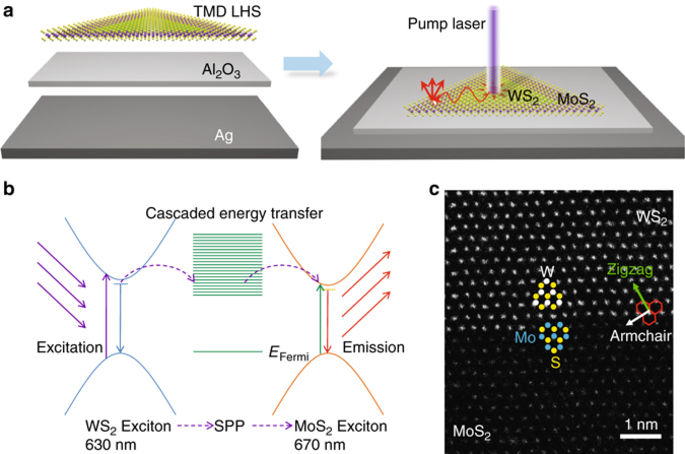当前位置:
X-MOL 学术
›
Nat. Commun.
›
论文详情
Our official English website, www.x-mol.net, welcomes your feedback! (Note: you will need to create a separate account there.)
Cascaded exciton energy transfer in a monolayer semiconductor lateral heterostructure assisted by surface plasmon polariton.
Nature Communications ( IF 14.7 ) Pub Date : 2017-06-26 , DOI: 10.1038/s41467-017-00048-y Jinwei Shi , Meng-Hsien Lin , I-Tung Chen , Nasim Mohammadi Estakhri , Xin-Quan Zhang , Yanrong Wang , Hung-Ying Chen , Chun-An Chen , Chih-Kang Shih , Andrea Alù , Xiaoqin Li , Yi-Hsien Lee , Shangjr Gwo
Nature Communications ( IF 14.7 ) Pub Date : 2017-06-26 , DOI: 10.1038/s41467-017-00048-y Jinwei Shi , Meng-Hsien Lin , I-Tung Chen , Nasim Mohammadi Estakhri , Xin-Quan Zhang , Yanrong Wang , Hung-Ying Chen , Chun-An Chen , Chih-Kang Shih , Andrea Alù , Xiaoqin Li , Yi-Hsien Lee , Shangjr Gwo

|
Atomically thin lateral heterostructures based on transition metal dichalcogenides have recently been demonstrated. In monolayer transition metal dichalcogenides, exciton energy transfer is typically limited to a short range (~1 μm), and additional losses may be incurred at the interfacial regions of a lateral heterostructure. To overcome these challenges, here we experimentally implement a planar metal-oxide-semiconductor structure by placing a WS2/MoS2 monolayer heterostructure on top of an Al2O3-capped Ag single-crystalline plate. We find that the exciton energy transfer range can be extended to tens of microns in the hybrid structure mediated by an exciton-surface plasmon polariton-exciton conversion mechanism, allowing cascaded exciton energy transfer from one transition metal dichalcogenides region supporting high-energy exciton resonance to a different transition metal dichalcogenides region in the lateral heterostructure with low-energy exciton resonance. The realized planar hybrid structure combines two-dimensional light-emitting materials with planar plasmonic waveguides and offers great potential for developing integrated photonic and plasmonic devices.Exciton energy transfer in monolayer transition metal dichalcogenides is limited to short distances. Here, Shi et al. fabricate a planar metal-oxide-semiconductor structure and show that exciton energy transfer can be extended to tens of microns, mediated by an exciton-surface-plasmon-polariton-exciton conversion mechanism.
中文翻译:

在表面等离子体激元极化的辅助下,单层半导体横向异质结构中的级联激子能量转移。
最近已经证明了基于过渡金属二卤化物的原子薄侧向异质结构。在单层过渡金属二硫化氢中,激子能量转移通常限制在短范围内(〜1μm),并且可能在横向异质结构的界面区域产生额外的损耗。为了克服这些挑战,在这里我们通过在Al 2 O 3顶部放置WS 2 / MoS 2单层异质结构以实验方式实现平面金属氧化物半导体结构盖的Ag单晶板。我们发现,在由激子表面等离激元激子-激子转换机制介导的混合结构中,激子能量的传递范围可以扩展到数十微米,从而允许从一个过渡金属二卤化物区域进行级联激子能量传递,从而支持高能激子共振。在横向异质结构中具有不同的过渡金属二卤化金属区域,具有低能激子共振。所实现的平面混合结构将二维发光材料与平面等离激元波导结合在一起,为开发集成的光子和等离激元器件提供了巨大的潜力。单层过渡金属二卤化物中的激子能量转移仅限于短距离。在这里,Shi等。
更新日期:2017-06-27
中文翻译:

在表面等离子体激元极化的辅助下,单层半导体横向异质结构中的级联激子能量转移。
最近已经证明了基于过渡金属二卤化物的原子薄侧向异质结构。在单层过渡金属二硫化氢中,激子能量转移通常限制在短范围内(〜1μm),并且可能在横向异质结构的界面区域产生额外的损耗。为了克服这些挑战,在这里我们通过在Al 2 O 3顶部放置WS 2 / MoS 2单层异质结构以实验方式实现平面金属氧化物半导体结构盖的Ag单晶板。我们发现,在由激子表面等离激元激子-激子转换机制介导的混合结构中,激子能量的传递范围可以扩展到数十微米,从而允许从一个过渡金属二卤化物区域进行级联激子能量传递,从而支持高能激子共振。在横向异质结构中具有不同的过渡金属二卤化金属区域,具有低能激子共振。所实现的平面混合结构将二维发光材料与平面等离激元波导结合在一起,为开发集成的光子和等离激元器件提供了巨大的潜力。单层过渡金属二卤化物中的激子能量转移仅限于短距离。在这里,Shi等。















































 京公网安备 11010802027423号
京公网安备 11010802027423号